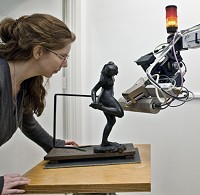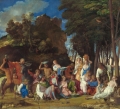The scientific research department uses scientific techniques and instrumentation to carry out its twofold mission: research and development of new materials for use in the conservation of works of art, and investigation into the methods and materials of artists. The Gallery's commitment to scientific research began in 1950 with the appointment of Dr. Robert L. Feller as technical advisor for conservation and curatorial activities. The department, which hired its first in-house scientist in 1976 and its first full-time scientist in 1984, now includes experts in the fields of chemistry, botany, conservation, and art history. The scientists work in collaboration with curators and conservators on topics related directly to the Gallery's collection, as well as on problems of general interest to the international conservation community. The department's fully equipped laboratory includes microscopic, chromatographic, and spectrophotometric instrumentation.
The results of the department's research are disseminated in publications and at national and international conferences, seminars, and symposia. The conservation community has adopted several new varnishes and conservation paints based directly on work done at the Gallery. Staff members collaborate with other conservation scientists and conservators in museums, conservation laboratories, and universities both nationally and internationally, and work with fellows, interns, and visiting scientists hosted each year by the department.




